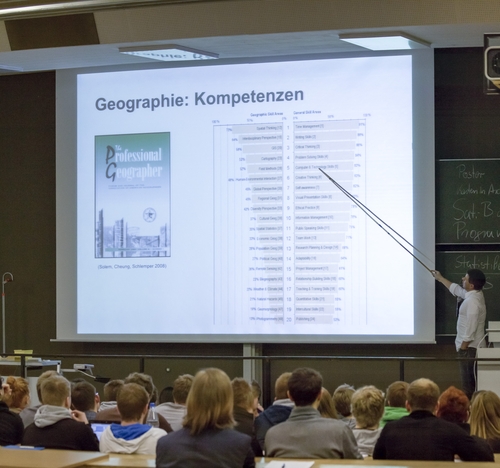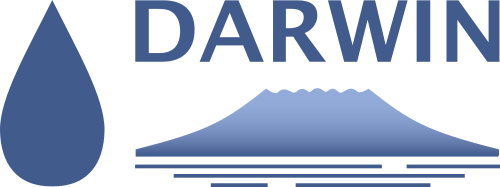Teaching and courses
Project staff:
Dr. Boris Thies
Description:
Lehrvideos AG-Bendix:
Lehrvideo: Thermische Windsysteme - Land-See Wind (http://dx.doi.org/10.5678/lcrs/dat.332)
Lehrvideo: Entstehung dynamischer Druckgebilde (http://dx.doi.org/10.5678/lcrs/dat.337)

Lehrveranstaltungen Fachbereich Geographie
Lehrveranstaltungen LCRS
Bachelor Geography
Python for climatology and remote sensing
Scientific work in physical geography, particularly remote sensing, climatology and atmospheric modelling, requires sound methodological skills in dealing with modern IT systems and the data types and programming languages used in these fields today. This course provides an introduction to the world's most widely used programming language "Python" with a special focus on climatological remote sensing applications. The theoretical content and concepts will be illustrated and practised in weekly exercises and practical examples. The development environment JupyterLab is used for explorative work. Illustrative examples using modern satellite systems will be worked through together in the course and in individual work. In addition to remote sensing applications, the evaluation of time series from ground stations will be part of the course.
Satellite Climatology
Satellite climatology is a branch of applied climatology. It deals with both the technical aspects of obtaining information about the Earth from a distance and the study of climate and its variations. The use of satellites makes it possible to observe conditions and processes in the atmosphere, land and oceans on a variety of spatio-temporal scales. By quantifying these processes and states, satellite remote sensing has enabled major advances in the understanding of the climate system and its changes. The course provides an overview of satellite remote sensing. First, the relevant basics from electromagnetic radiation to satellite orbits will be covered. Subsequently, the application to climatological questions will be illustrated with practical examples. The main programming language used is R.
Remote Sensing with Google Earth Engine
The course introduces students to working with satellite data using Google Earth Engine. Google Earth Engine (GEE) is a cloud-based computing platform for geospatial data analysis on a global scale that combines an extensive archive of satellite imagery with application programming interfaces. The course essentially covers the following aspects:- Introduction to GEE
- Exploring Datasets
- Raster visualisation and interpretation
- Image processing
- Spectral indices
- Image classification
- Time Series Analysis
M.Sc. Physical Geography
Climate Impact Studies: Studying forest growth response to drought using satellites
Intense drought events such as those in 2003 and 2018 have a variety of effects on forests, ranging from leaf wilting and premature senescence to tree death. Following the 2003 and 2018 droughts, beech trees in Central Europe showed premature leaf discolouration and defoliation, as well as widespread but highly heterogeneous mortality. However, beech susceptibility can vary spatially and in severity both within stands and at larger forest scales. Therefore, identifying the spatial and temporal variation of drought-related effects is important for a better understanding of drought-induced growth decline and mortality, and the factors that increase the vulnerability of forests to drought. Satellite imagery is well suited for spatio-temporal monitoring of drought impacts as it provides consistent and regular measurements over large areas. With the help of different satellite sensors, the Kellerwald National Park is investigating how the reaction of trees develops during intense drought events and how the spatial and temporal resolution of the satellite sensors influences the ability to detect drought signals. The programming language used is Python. Previous knowledge of Python is helpful, but not mandatory. The relevant knowledge is taught during the course.
Climate Impact Studies: Machine learning based wildfire susceptibility mapping
Wildfires are an integral component of terrestrial ecosystems that affect the carbon cycle and shape ecological development via disturbance and regeneration. Nonetheless, wildfires negatively affect humans, especially in the wildland-urban interface, inducing catastrophic effects on infrastructure, ecosystem services, and human lives. The intensity and severity of wildfires has increased significantly in recent decades, primarily due to warm and dry conditions associated with climate change. There is evidence that wildfires may become more severe and intense in the future due to climate change. The increasing intensity and severity of wildfires may warrant a rethinking of fire management. Lands that have previously been limited suppression zones could now require increased suppression effort to mitigate impacts to humans and vulnerable ecosystems. It is therefore important to produce susceptibility maps for wildfire management. Wildfires are the result of complex and non-linear interactions between all the fire drivers operating at different spatial and temporal scales, namely climate, vegetation, and human activity, thus they are extremely difficult to model. Machine learning algorithms can handle nonlinear and high-dimensional data and are promising approaches for predicting wildfire susceptibility. In the course we will create a fire susceptibility map. For this, we will use machine learning methods and different satellite- and model-based data sets. The programming language used is Python. Previous knowledge of Python is helpful, but not mandatory. The relevant knowledge is taught during the course.
Climate Impact Studies: Machine learning for climatology and remote sensing
Machine learning methods are of great importance for climate research. The course covers the main ML methods (tree-based models and neural networks) and their application. First, essential Python basics will be covered. The theoretical foundations of the ML methods will be elaborated through student presentations. Based on this, the practical application will be done by means of climatological case studies. This mainly involves the use of satellite-based remote sensing data. The programming language used is Python. Previous knowledge of Python is helpful, but not mandatory. The relevant knowledge is taught during the course.
Aktuelle mögliche Themen für Abschlussarbeiten
Abgesehen von den im Folgenden genannten Themen hinaus können natürlich auch eigene Interessen bei den Abschlussarbeitsthemen berücksichtigt werden. Mögliche Anregungen finden Sie unter Projects and facilities.
- Untersuchung der Resistenz, Erholung, Resilienz mittelhessischer Eichen als Reaktion auf Trockenheit mittels dendroökologischer Methoden (BSc oder MSc) (Jörg Bendix)
- Niederschlagsentstehung in der El Niño Region S-Ecuador - eine Auswertung von Radar Daten (BSc oder MSc) (Jörg Bendix)
- Untersuchung des Zusammenhangs zwischen kosmischer Strahlung und der Nebelfrequenz in Deutschland (MSc) (Jörg Bendix)
- Analyzing variability of rainfall and climatic parameters from automated gauge stations in the Galapagos Archipelago (Nazli Turini)
- Feldsegmentierung in Planet3, Sentinel-2 und/oder Hyperspektraldaten.
Ziel ist die räumliche Eingrenzung für etwaige Klassifikationen. (BSc oder MSc) (Leander Leist) - Ableitung von EnMap Spektralbereichen auf Basis von Sentinel-2 Daten.
Ziel ist die Vorhersage hyperspektraler Informationen in dem Raum, der nicht durch EnMap Daten abgedeckt wird. (BSc oder MSc) (Leander Leist) - Deep Learning Ansätze für die Feldfruchtkartierung in hyperspektralen EnMap Daten.
Ziel: Vorstudie zum Potenzial von DL im Bereich der Projektzielsetzung. Hier geht es darum bekannte einfache Architekturen auszuprobieren. (BSc oder MSc) - Anwendung von Transformer Architekturen an EnMap Daten im spektralen oder temporalen Bereich, (MSc) (Leander Leist)
Bei Interesse an einem Thema wenden Sie sich bitte an die in Klammern genannte Kontaktperson.
Abgeschlossene Abschlussarbeiten
| 2010 | Relationship between SEVIRI thermal radiances and RADOLAN derived rain rate | B.Sc. |
| 2010 | Validation of the simulation results of the winter storm Kyrill | B.Sc. |
| 2010 | Fog formation in a tropical lowland forest of French Guiana - An analysis of the coherence between synoptic processes and fog frequency based on NCEP- and satellite-based data | B.Sc. |
| 2010 | Improved Irradiation Modeling for Solar Energy Applications in Europe Using Publicly Available Resources | B.Sc. |
| 2010 | Predicting land use/land cover changes in a tropical mountain forest of Ecuador for future SVAT prediction | B.Sc. |
| 2010 | Remote Sensing and Modeling of Atmoshperical Pathways and Scources of Nutrients into a Tropical Montane Cloud Forest Geostatistical Analyses in South Ecuador | B.Sc. |
| 2010 | Modelling and validation of Land Use/Land Cover change to simulate future rainforest dynamics in tropical South America: a GIS-based ananysis | B.Sc. |
| 2010 | Possible implications of REDD on land and forest tenure - exemplified by the Indonasian case | M.Sc |
| 2011 | Deriving spatial Leaf Area Index for a tropical mountain forest in Southern Ecuador | B.Sc. |
| 2011 | A GIS-based analysis of the upper tree line in southern Ecuador | B.Sc. |
| 2011 | Retrospective land cover classification of nothern South America using NOAA AVHRR data: a classification tree approach | B.Sc. |
| 2011 | Feasibility Study on the Application of Hyperspectral Classifikations to an Atutomatic Detection of Laryngeal Disorders | B.Sc. |
| 2012 | Analyse räumlicher Modelle zu Schätzung der oberirdischen Biomasse anhand von Fernerkundungsdaten und Umweltvariablen | B.Sc. |
| 2012 | A land cover classification of northern South America using NOAA AVHRR data: a classification tree approach | B.Sc. |
| 2012 | Detection of Land-cover and Vegetation Change by Invasive Woody Species Spread at the Rio Negro, Argentina, Using Remote Sensing | M.Sc |
| 2012 | Night Light imagery and infrastructure assessment: Calculating the economic potenial of global rural electrification based on hybrid PV-Battery-Diesel system | M.Sc |
| 2013 | An analysis of the relationship between the occurrence of Taiwan`s Tropical Montane Cloud Forest and low cloud frequencies derived from Terra/Aqua-MODIS | B.Sc. |
| 2013 | The influence of drop size distributions on the relationship between liquid water content and radar reflectivity | M.Sc |
| 2013 | Measuring pasture degradation of the Tibetan Plateau using spectral dissimilarities and indices | M.Sc |
| 2014 | Effects of Recent Climate Variability on the Vertical Rainfall Structure in the Ecuadorian Andes | B.Sc. |
| 2014 | Comparsion of two algorithms for individual tree crow detection in southern Ecuador | B.Sc. |
| 2014 | Simulation of low stratus clearance based on Meteosat Second Generation data | B.Sc. |
| 2014 | Calculating Plant Height and Leaf Area Index Using Altitude (Balloon) Photography | B.Sc. |
| 2014 | Analysing Social-Ecological Conditions for Migration in the Sahel - Application of Bayesian Belief Networks as an Integrative Method | M.Sc |
| 2014 | Simulating hyper-spectral reflective properties of human skin using a radiative transfer model | M.Sc |
| 2014 | Evaluation of Orographic Rainfall Enhanced by Seeder-Feeder Mechanism Using a Micro Rain Radar in Southern Ecuador | M.Sc |
| 2015 | Zeitliche Veränderung von Wetterextremea in Südecuador | B.Sc. |
| 2015 | Remote Sensing based measures of tree diversity in the Southern Ecuadorian Andes | M.Sc |
| 2015 | Potenial of Remotely Sensed Image Textures for Predicting Herbivory in the Ecuadorian Andes | M.Sc |
| 2016 | Analysis of different fog event dynamics using ground-based measurements techniques | B.Sc. |
| 2016 | Coherence Analysis of lWind Speed and Visibility during a Fog Life Cycle using Continuous Wavelet Transform | B.Sc. |
| 2017 | Differences in functional traits of temperate C3 grasslands under ambient and elevated CO2 conditions- an analysis based on hyperspectral imagery | B.Sc. |
| 2017 | Dependence of ground-near CO2-concentrations to atmospheric stability and exemplary large-scale weather conditions | B.Sc. |
| 2017 | Influence of aerosols and humidity on LiDAR wind measurements | M.Sc. |
| 2017 | Simulation of low stratus clearance basedon Meteoast Second Generation data | M.Sc. |
| 2017 | Hyperspectral remote sensing of biological soil crusts in the Atacama Desert | M.Sc. |
| 2018 | Regressionsbasierte Vorhersage von Nebel auf Basis meteorologischer Messgrößen mit einem maschinellen Lernverfahren | M.Sc. |
| 2018 | Changes in climate extremes in southern Ecuador - a statistical downscaling approach | M.Sc. |
| 2019 | Multi-annual assessment of a new consistent AVHRR Land Surface Temperature product using MODIS LST and in situ measurements | M.Sc. |
| 2019 | Rekonstruktion der Oberflächentemperatur für bewölkte Regionen aus Neteosat-10 und AMSR2 Daten | M.Sc. |
| 2019 | Development and evaluation of a fog forecasting framework using Hidden Markov Model | M.Sc. |
| 2020 | Discrimination of snowfall and rainfall with Meteosat SEVIRI and CloudSat/GPM DPR - a machine learning aproach | M.Sc. |
| 2021 | Severe Convection in lAtmospheric Blocking Situations - A Comparative Analysis of High-Temporal MSG SEVIRI Data | M.Sc. |
| 2021 | PredictingViolent Confrlict in Africa - Leveraging Open Doedata and Deep Learning for Spatio-Temporal Event Detection | M.Sc. |
| 2021 | Untersuchung des Zusammenhangs zwischen Wolkentyp und Regenrate auf Basis von Satellitendaten | M.Sc. |
| 2021 | Machine learning-based snow cover modelling in the high mountain region of Kazbegi, Georgia | M.Sc. |
| 2021 | Satellitengestützte Erfassung von Trockenstress nordhessischer Buchenwälder | M.Sc. |
| 2021 | Hierarchical Clusteranalysis of Meteosat SEVIRI Data and their develooopment over time before fog events to improve for forecasting | B.Sc. |
| 2021 | Validation of the GPM-DPR snowfall detection ability with ground-based station data from the German Weather Service | B.Sc. |
| 2021 | Räumliche Modellierung der Kaltluftbildung im tropischen Tiefland mit dem Modell Microclima im Bezug zur nächtlichen Nebelbildung | B.Sc. |
| 2021 | Spatial-explicit calculation of close-to-ground fog liquid water content for the Pan de Azúcar National Park (Chile) based on Landsat8 data | B.Sc. |
| 2021 | Quantitative Analyse der städtischen Wärmeinsel im Stadtgebiet Marburgs mittels Landsat 8 Satellitendaten für die Sommer 2013-2020 | B.Sc. |
| 2021 | Die Auswirkung der Abholzung des Legal-Amazonas im brasilianischen Bundesstaat Mato Grosso auf die lokale atmosphärische CO2-Konzentration sowie deren Folgen auf den Niederschlag, die Temperaturen und die Evapotranspiration | M.Sc. |
| 2022 | Cross-generational synthesis of the infrared and water vapor signals: Deriving broad-band data of Meteosat´s first generation with narrow-band second generation data | B.Sc. |
| 2022 | The spatio-temporal daytime cloud frequency distribution in the Galápagos Archipelago as seen from MODIS cloud mask data | B.Sc. |
| 2022 | A fog frequency map for the Galápagos archipelago based on MODIS cloud data | B.Sc. |
| 2022 | Mikroklimatische Analyse der Maximilianstraße in Speyer in besonderem Hinblick auf die Möglichkeiten zur Anpassung an Klimawandelfolge | B.Sc. |
| 2022 | Nebelvorhersage mit einem mehrlagigen Perzeptron unter Berücksichtigung verschiedener Verlustfunktionen - Eine Untersuchung mittels Stations-, Satelliten- und Modelldaten | M.Sc. |
| 2022 | Vergleich von mit Drohnen und Flugzeugen aufgenommenen Luftbildern und deren Auswertungsmöglichkeiten für die forstwirtschaftliche Praxis | M.Sc. |
| 2023 | Satellitengestützte Untersuchung der Resistenz, Erholung und Resilienz eines nordhessischen Buchenwaldes als Reaktion auf Trockenheit. | B.Sc. |
| 2023 | Field Boundary Delineation in Small-Scale Farming Systems Using Deep Learning | M.Sc. |
| 2023 | Analysis of cloud microphysical properties to determine the spatio-temporal occurrence of Garúa in Galápagos | M.Sc. |
| 2023 | Spatio-termporal variations of drizzle in the Galapágos Archipelago based on CloudSat/CALIPSO | M.Sc. |
| 2023 | Die Resistenz, Erholung und Resilienz ausgewählter Baumarten im Marburger Universitätswald bei Dürre-Ereignissen | B.Sc. |
| 2023 | Satellitengestützte Analyse der Phänologie der Laubwälder im Nationalpark Kellerwald-Edersee | B.Sc. |
| 2023 | Spatial MaxEnt and Random Forest Bee Habitat Suitability Modeling Within Biased Sampling Distribution | M.Sc. |
| 2024 | GIS-/Fernerkundungsgestützte Analyse des Ist-Zustandes und Potentialen von Maßnahmen zur Erhöhung der Klimaresilienz von Fließgewässern im Einzugsgebiet der Lippe unter beonderer Berücksichtigung der Gewässerbeschattung - Methodenentwicklung und Anwendung im Rahmen des F&E-Vorhabens KliMaWerk | M.Sc. |
| 2024 | Analysis of Surface Urban Heat Islands during 2019´s heatwave in Hesse, Germany | M.Sc. |




